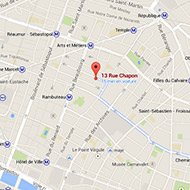JACQUELINE DAURIAC : Pleasure without remorse
It might be difficult to apprehend Jacqueline Dauriac?s work, its subtlety does not have direct equal that the care with witch the artist nihilities the material for the benefit of the light, the pure and diffuse color, the sensation of been somewhere in the midst of a dream. Jacqueline Dauriac seems to show a particular application to not leave anything very bulky to Art, as she confess to me during one of your rendezvous : ?Ideally it should no more be any object?.
A first approach would consist to describe the settle devices: here, colored glass panels that a gleam of a coming light traverse to come and spread on the wall thousands bluish or glowing tints, there a box of a simple shape (a round, a trapeze) from which a colorful light come splash the body of a woman in black, or in red. Describe like this the things would start from the end, reveal the ?thing? and prevent to believe in it. So it would suit better to take another approach, to pay attention to the tale that the artist entrust to us of her meetings and her fascinations. Retake the story from the beginning in order to trace not the road of a woman but the one of her gaze.
There is first the child?s gaze, eager of details and flowing by painting, which her father reveals to her in the Prado in Madrid or in the Offices? Gallery in Florence. The souvenir of a still life discovered in a room?s corner, a grain of grapes painted, fascinating of reality, so transparent that we believe into testing its pulp. Elsewhere, Jean Clouet?s portraits, with their extravagant ?fraise-ruff? and their gloomy velvet coat, but also Manet?s one, posing with tenderness, a dusk light on the cheek of the Ladies and Gentleman of the upper society. And then there is astonishment in front of a Delacroix : a purple carriage with a yellowish shadow. Impossible, unthinkable.
Later however, there will be this amazed gaze of Tanger?s beauty and Morocco?s colors, where the sun projects at the feet of men turquoise blue shadows. She needed to see them to believe in it and embraced her vocation to hill the dull grey shadows that here are yours. Since, Jacqueline Dauriac goes as a guide, giving colors to sorrows and preparing your pursuit of happiness, recreating the experience of those colored shadows as a generous demiurge.
Through the years, there is finally this look at women and the ineffable disturbance of their bodies? beauty. It is of course the painter's gaze on his model, almost obscene in scrutinizing beauty from all angles, from inside out : the privileged experience of creation in an artist?s studio, when the hand is stretched out and the curve of a breast emerged.
Jacqueline Dauriac remembers then her meeting with the transvestite Marie-France, this "woman's dream" carried by the overbidding of an overwhelming femininity, from which a project of photographic portraits was born (Marylin-Marie-France, 1975). Then came the first performance installations (Yellow Circle for Women in Red, 1985 ; Blue Trapeze for Women in Black, 1986) whose objective was not so much to put the woman in a working situation as to force us to move this reverential look we take at objects towards the people around us, : "People know how to look at a painting with high standards and attention, I would like them to do it in real life." And the artist to exhort us to ?look at an apple like you would look at a Cézanne?.
Because finally, the device must not be the subject of our attention here. Its radicalism and simplicity (a simple form, pure colors) serve above all to create an conductive environment to our commitment, to create an emotional perspective from witch those lines of escape all converge towards the woman invited to our lust, a free and charismatic presence. It is not a question of activating anything for the viewer-looker. The subject of the work precedes us (whether it is the place where the work or the performer is inscribed that achieve its integrity) and Jacqueline Dauriac only works to offer it the finest setting ever possible, freezing time from its contemplation in the way of a painter of a sculptor.
Her gaze on the world and its wonders then take te form of a caress, following the position of moving away from the representation to grasp the subject with both hands, with full desire, and present it to us in its simplest apparatus. The quest for pleasure without remorse, served by a sensual approach that culminates in the recent drawings on tracing paper that Jacqueline Dauriac makes with the extremity of her fingers, she ? that in a lauch ? confide in me at the end of our exchanges ; ?caressing the paint is all the more delightful than doing painting?.
Thibault Bissirier, June 2018
Translated by Diane de La Thibauderie


